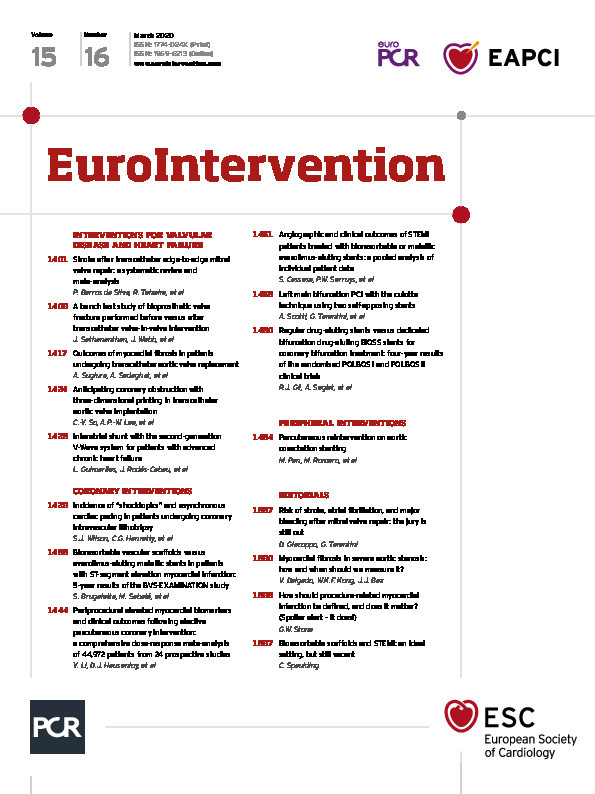
The evidence demonstrating the association between myocardial fibrosis and outcomes after aortic valve replacement in patients with severe aortic stenosis is growing1,2,3,4. The response of the left ventricle to the pressure overload imposed by the stenotic aortic valve is characterised by myocyte hypertrophy with increased muscle fibre diameter and the parallel addition of new myofibrils to maintain left ventricular (LV) systolic function5. Subsequent myocyte apoptosis and replacement fibrosis lead to heart failure, which has been associated with poor outcomes after aortic valve replacement6. The pressure overload also stimulates the secretion of TGF-β1 and the angiotensin-converting enzyme promotes reactive fibrosis which leads to a low grade of inflammation that, together with a reduction in the capillary density, causes myocyte degeneration, exhaustion of the cellular adaptation and myocyte loss. The replacement fibrosis closes the vicious circle of myocyte degeneration, exhaustion of the cellular adaptation and myocyte loss, which is enhanced by increased secretion of cytokines and reduction in the capillary density. Early detection of this adverse remodelling is important in order to refer patients with severe aortic stenosis for aortic valve replacement in a timely manner and improve outcomes, precluding the development of heart failure. However, it remains debated as to how and when we need to assess the presence of reactive and replacement myocardial fibrosis.
It is well known that LV ejection fraction is an insensitive parameter to detect early structural changes of the LV myocardium (fibrosis) that may not be reversible after aortic valve replacement7. In contrast, LV global longitudinal strain, a measure of LV myocardial deformation, has been shown to reflect myocardial fibrosis better than LV ejection fraction and to have incremental prognostic value8,9. Cardiovascular magnetic resonance (CMR) is the imaging technique to detect replacement myocardial fibrosis by means of late gadolinium enhancement (LGE) or reactive fibrosis using T1 mapping techniques. Replacement fibrosis is visualised as hyperenhanced areas surrounded by healthy myocardium after intravenous administration of gadolinium. Depending on the distribution, replacement fibrosis can be classified as ischaemic (subendocardial or transmural enhancement following the course of the coronary arteries) or non-ischaemic (focal, patchy or midventricular). Among 674 patients with symptomatic severe aortic stenosis, 51% presented with replacement myocardial fibrosis, the majority with a non-ischaemic pattern3. In contrast, reactive fibrosis is assessed with T1 mapping techniques calculating the extracellular volume (ECV). In a large cohort of patients with severe aortic stenosis2, the ECV was 27.7±3.6%. When dividing the population according to tertiles of ECV, those within the highest tertile (>29.1%) had higher operative risk, more heart failure symptoms, larger LV and left atrial volumes and LV mass2. Both replacement and reactive fibrosis have been associated with increased all-cause mortality after aortic valve replacement2,3. However, in clinical practice CMR is not the first imaging technique used to evaluate patients with symptomatic severe aortic stenosis who will be treated with TAVI. Relatively low availability, long times of acquiring and processing data and specific expertise to interpret the data limit the use of this technique, even if there are new techniques to improve the speed of acquisition and processing of LGE and T1 mapping data without losing quality10,11. Accurate assessment of the severity of aortic stenosis and measurement of the aortic valve annulus and calibre of the femoral arteries are cornerstones for selecting the patients and planning the TAVI procedure. This can be carried out with echocardiography and computed tomography which can be acquired quickly and which are easier to interpret than CMR data12. How and when should we assess the presence of myocardial fibrosis in patients who are candidates for TAVI?
In the current issue of EuroIntervention, Sugiura et al4 used a validated risk score to identify patients with aortic stenosis who probably have midwall myocardial fibrosis1. They evaluated the association of this score with the occurrence of LV reverse remodelling, improvement in LV systolic function and long-term outcomes4.
The score included age, sex, high-sensitivity cardiac troponin I, presence of strain pattern in the surface electrocardiogram and peak aortic valve velocity. The 207 included patients were divided according to the median value of the midwall fibrosis risk score (≥52 vs <52). A higher midwall fibrosis risk score was significantly associated with less reduction in LV volumes and LV mass index and was not associated with improvement in LV ejection fraction. In addition, there were no differences in the five-year all-cause death rates between patients with a midwall fibrosis risk score ≥52 versus patients with a midwall fibrosis risk score <52. This is surprising as this finding seems to contrast with previous results. In the study by Chin et al1, among 291 patients with moderate and severe aortic stenosis, the midwall fibrosis risk score was able to differentiate those patients with low (3.9/100 patient-years) versus those with high (30.1/100 patient-years) aortic stenosis-related event rates (composite of cardiovascular mortality, congestive heart failure, and new symptoms of syncope, angina or dyspnoea). However, it should be acknowledged that the study by Chin et al1 included asymptomatic patients, whereas the patients in the study by Sugiura et al4 included patients with symptomatic severe aortic stenosis treated with TAVI. Therefore, one could deduce from this that, when severe aortic stenosis presents with symptoms, the midwall fibrosis risk score may not be sensitive enough to identify the patients who will have poor prognosis.
When and how should we assess myocardial fibrosis in patients with severe aortic stenosis? If the patients are asymptomatic and there is no apparent damage to the left ventricle based on conventional echocardiographic assessment, the midwall fibrosis risk score and LV global longitudinal strain assessment could be readily available and inexpensive methods to help us to identify the patients who could be referred earlier for intervention. In contrast, among those patients with symptoms, even if the LV ejection fraction is still preserved, CMR techniques would be more sensitive to identify the patients who may not benefit as much as we might expect from aortic valve replacement. However, this does not mean that the aortic valve replacement would be futile since the studies were not designed to answer that question.
Funding
The Department of Cardiology of the Leiden University Medical Center has received unrestricted research grants from Abbott Vascular, Bayer, Biotronik, Medtronic, Boston Scientific, GE Healthcare, and Edwards Lifesciences.
Conflict of interest statement
J.J. Bax has received speaker fees from Abbott Vascular. V. Delgado has received speaker fees from Abbott Vascular, Edwards Lifesciences, Medtronic and GE Healthcare. The other author has no conflicts of interest to declare.
Supplementary data
To read the full content of this article, please download the PDF.

